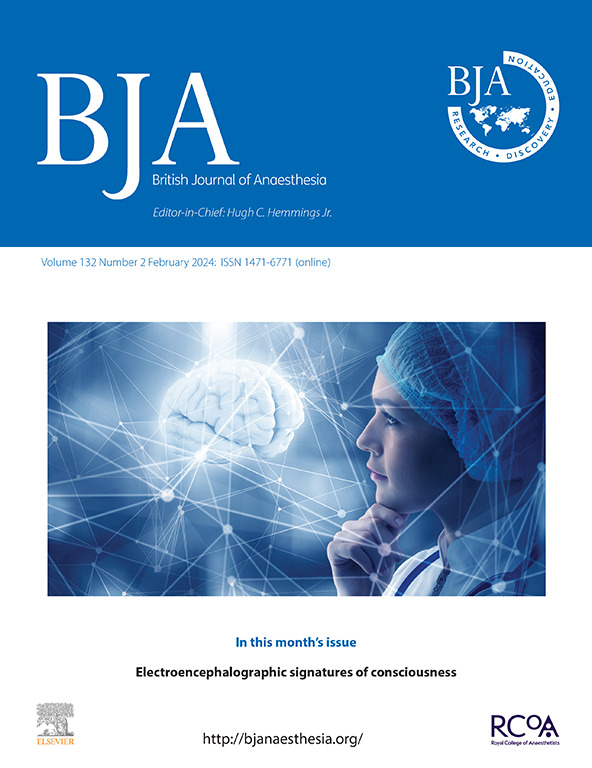Effect of intraoperative dexmedetomidine on prognosis in patients with cancer undergoing surgical procedures: a systematic review and meta-analysis.
IF 9.1
1区 医学
Q1 ANESTHESIOLOGY
引用次数: 0
Abstract
BACKGROUND Cancer places a significant burden on patients and healthcare systems. Dexmedetomidine, an α2 adrenergic agonist commonly used in anaesthesia, has potential effects on cancer biology. We systematically reviewed and analysed the impact of intraoperative dexmedetomidine on postoperative survival and tumour recurrence in patients with cancer. METHODS We conducted a comprehensive search of PubMed, Web of Science, Embase, and the China National Knowledge Infrastructure up to April 2024. Two researchers extracted data including authors, year, country, study design, follow-up, patient characteristics, and hazard ratios (HRs) with 95% confidence intervals (CIs) for overall survival and recurrence-free survival. Quality assessment was conducted using the Cochrane tool for randomised controlled trials (RCTs) and the Newcastle-Ottawa Scale for retrospective studies. RESULTS The review identified 12 studies: six RCTs and six retrospective studies. In the RCTs, intraoperative dexmedetomidine showed no significant effect on overall survival (odds ratio [OR] 0.87, 95% CI 0.67-1.13, P=0.29) but improved recurrence-free survival (OR 0.65, 95% CI 0.47-0.91, P=0.01). Retrospective studies indicated that dexmedetomidine was associated with decreased overall survival (post-matching HR 1.52, 95% CI 1.15-2.00, P=0.003), and had no significant effect on recurrence-free survival (post-matching HR 1.29, 95% CI 0.96-1.72, P=0.09). CONCLUSIONS Meta-analysis reveals inconsistent evidence regarding impact of intraoperative dexmedetomidine on cancer outcomes after surgery. RCTs suggest improved recurrence-free survival, whereas retrospective studies suggest potential reductions in overall survival. The limited and contradictory data highlight the necessity for more high-quality RCTs to clarify the effects of dexmedetomidine on survival and prognosis in this population.术中使用右美托咪定对肿瘤手术患者预后的影响:一项系统综述和荟萃分析。
癌症给患者和卫生保健系统带来了沉重的负担。右美托咪定是一种常用于麻醉的α2肾上腺素能激动剂,对肿瘤生物学有潜在影响。我们系统地回顾和分析术中使用右美托咪定对癌症患者术后生存和肿瘤复发的影响。方法对截至2024年4月的PubMed、Web of Science、Embase和中国国家知识基础设施数据库进行综合检索。两位研究人员提取的数据包括作者、年份、国家、研究设计、随访、患者特征和总生存期和无复发生存期的95%可信区间(ci)的风险比(hr)。采用Cochrane随机对照试验(RCTs)工具进行质量评估,采用纽卡斯尔-渥太华量表进行回顾性研究。结果本综述纳入了12项研究:6项随机对照试验和6项回顾性研究。在rct中,术中右美托咪定对总生存率无显著影响(比值比[OR] 0.87, 95% CI 0.67 ~ 1.13, P=0.29),但改善无复发生存率(OR 0.65, 95% CI 0.47 ~ 0.91, P=0.01)。回顾性研究表明,右美托咪定与总生存率降低相关(匹配后危险度1.52,95% CI 1.15-2.00, P=0.003),对无复发生存率无显著影响(匹配后危险度1.29,95% CI 0.96-1.72, P=0.09)。结论meta分析显示术中使用右美托咪定对术后癌症预后影响的证据不一致。随机对照试验提示无复发生存率提高,而回顾性研究提示总生存率可能降低。有限和相互矛盾的数据强调了需要更多高质量的随机对照试验来阐明右美托咪定对该人群的生存和预后的影响。
本文章由计算机程序翻译,如有差异,请以英文原文为准。
求助全文
约1分钟内获得全文
求助全文
来源期刊
CiteScore
13.50
自引率
7.10%
发文量
488
审稿时长
27 days
期刊介绍:
The British Journal of Anaesthesia (BJA) is a prestigious publication that covers a wide range of topics in anaesthesia, critical care medicine, pain medicine, and perioperative medicine. It aims to disseminate high-impact original research, spanning fundamental, translational, and clinical sciences, as well as clinical practice, technology, education, and training. Additionally, the journal features review articles, notable case reports, correspondence, and special articles that appeal to a broader audience.
The BJA is proudly associated with The Royal College of Anaesthetists, The College of Anaesthesiologists of Ireland, and The Hong Kong College of Anaesthesiologists. This partnership provides members of these esteemed institutions with access to not only the BJA but also its sister publication, BJA Education. It is essential to note that both journals maintain their editorial independence.
Overall, the BJA offers a diverse and comprehensive platform for anaesthetists, critical care physicians, pain specialists, and perioperative medicine practitioners to contribute and stay updated with the latest advancements in their respective fields.

 求助内容:
求助内容: 应助结果提醒方式:
应助结果提醒方式:


